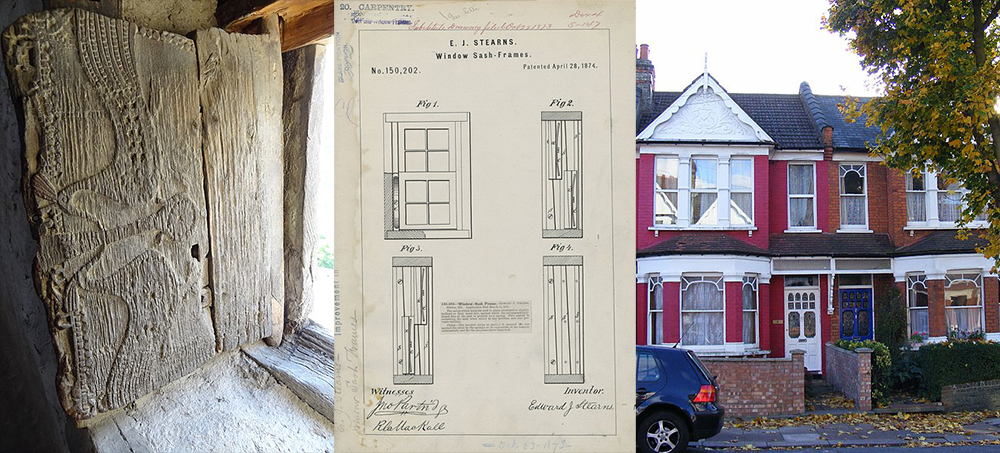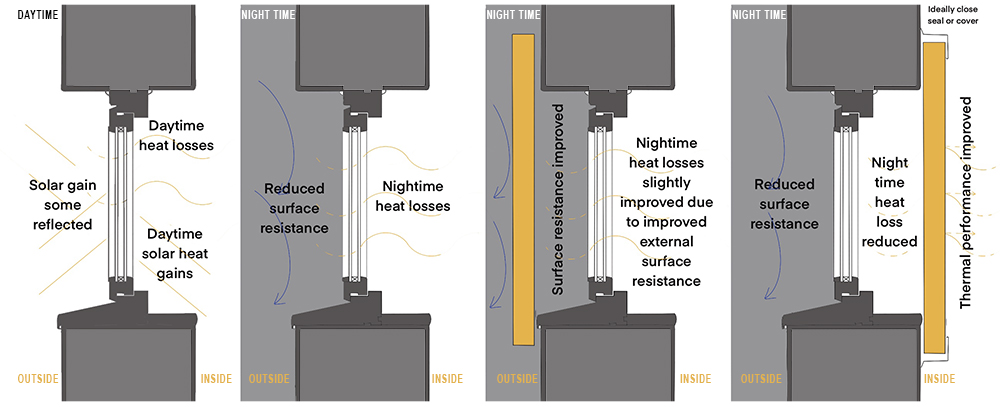Insulating shutters
Contents |
[edit] The development of shutters
Shutters, both internally fitted and externally fitted, were a relatively commonplace feature of European houses, with externally fitted shutters, still more common in warmer European climates due to their shading benefits, whilst internally fitted solid panel shutters were more common in the UK.
Whilst we perhaps don't associate shutters as a form of insulation and draft exclusion, they did and still can serve as an effective thermal element of the building fabric, to help keep the heat in and the cold out, especially during medieval times when windows had no glass at all!
[edit] A brief history of shutters
Although the Romans used glass as early as 100 AD, during the medieval period in the UK, most windows were unglazed, and shutters did many of the jobs that glass now does, keeping out wind, rain, insects, birds and intruders, and acting as a crude form of insulation. Whilst the Tudor period saw the introduction of glass, it was in small amounts, often stained glass and expensive. Even during the start of the Stuart period this remained true, but it slowly changed towards the end of the 16th Century as window or cylinder glass became more available and affordable and became part of sash windows introduced during this time.
In Georgian times glass became more available and designs had integrated internal shutters which folded back into architraves forming window reveals, often with the sides hinged and an additional panel placed manually at the centre. Casement windows made by blacksmiths with relatively small panes of glass were more likely to have had external shutters. These types of installation served a practical, fashion, privacy, noise and insulation function right up to the 1840s, and although during the Victorian era curtains became more popular, internal sash shutters would still be found installed in street facing terraced houses, primarily for privacy.
[edit] Restoring shutters
A study published in 2019 by English Heritage 'reserach into the thermal performance of traditional windows: timber sash windows" suggested that well fitting shutters, not necessarily specifically insulating types but well fitting timber shutters such as the original sash window shutters might have been, could save as muh as 64% heat loss of from a traditional building if used correctly. Whilst Historic Environment Scotland suggest 'timber shutters can reduce heat loss by 51%' and residents should; "consider having ill-fitting shutters restored. If the original shutters have been removed, it’s possible to have new shutters made."
[edit] Contemporary thermal shutters
The first home to achieve net zero according to the UKGBC's Framework is the final home of services engineer Max Fordham, where the "building’s thermal envelope, its ventilation system and its windows are designed so that the heat loss on a freezing cold winter’s day is no more than the heat generated by people living in the house."
Part of his and Bere architects design was to include "automated, insulated shutters (to) allow the windows to become much more insulating at night so that the windows are thermally a net benefit every day". The windows and their positions are designed so that electric lights are not needed during the day. The Max Fordham engineers website states "vertical window shutters are a re-imagining of sash-window technology".
[edit] Building physics
In a scenario where no shutters are used, solar heat gain during winter months can be beneficial. Whilst low e coatings help reduced heat losses, un-shuttered windows, especially single glazed will lose most of that heat during colder nights. In fact up to 30% of the energy lost in dwellings is through windows, potentially more if they are poorly insulated and leaky.
Whilst external shutters are not thought of as having a great deal of thermal benefit, because they sit outside the thermal line of a building, they do act as a rainscreen, creating a protected airspace in between thus increasing surface resistance known a Re (resistance external) or Ro (resistance outside) irrespective of the material used.
By placing blinds or shutters internally, even if they are simple timber panel but well fitting the fabric performance is increased because they act as an insulant. By designing these with tight fitting edges or seals and constructing them from insulative material the reductions can be significant.
In high performing fabric buildings such as those built to Passivhaus standards, with the correct orientation, the windows can act as a net positive in terms of heat gain, storing the heat gained in the day by shutting the windows off from het loss in the evenings.
So with or without glass it seems that the simple shutter, steeped in the historical vernacular of buildings, in and out of fashion, still has its role to play, not only in the shading and ventilation requirements of the plantation or colonial internal shutters of the US, or the storm protection of the Bahamas or Bermuda, but also of the English Georgian type of shutter more akin to the quaker panel style, in retaining precious heat inside homes.
Image references: sludgegulper - https://commons.wikimedia.org/wiki/File:N11_sash_windows.jpg / Ausat - https://commons.wikimedia.org/wiki/File:Window_shutter_carving_detail,_Altit_Fort.jpg and https://commons.wikimedia.org/wiki/File:E._J._Stearns_Window_Sash-Frames_-_DPLA_-_5ee2922864bea7ef1ae2fc30a3234d5d_(page_1).jpg
[edit] Related articles on Designing Buildings
- Building fabric.
- Doors.
- Exterior shutters.
- External doors.
- Fire doors in buildings.
- Formwork.
- G-value.
- Heat loss.
- Heat transfer.
- Insulation.
- K-value.
- Louvre (or louver).
- Shading coefficient.
- Self-closing device.
- Thermal admittance.
- Thermal resistance.
- Types of blinds.
- Types of door.
- Types of shutters.
- U-value.
- Window.
[edit] External references
- https://www.bere.co.uk/architecture/max-fordham-house/
- https://www.theguardian.com/technology/2022/jan/14/max-fordham-obituary
- https://www.ukgbc.org/ukgbc-work/net-zero-carbon-buildings-framework/
- https://www.maxfordham.com/projects/max-fordham-house
- https://www.historicenvironment.scot/advice-and-support/your-property/saving-energy-in-traditional-buildings/sash-windows-how-to-reduce-heat-loss/#use-shutters-and-curtains_tab
- https://www.buildingconservation.com/articles/shutters/shutters.htm
Featured articles and news
RTPI leader to become new CIOB Chief Executive Officer
Dr Victoria Hills MRTPI, FICE to take over after Caroline Gumble’s departure.
Social and affordable housing, a long term plan for delivery
The “Delivering a Decade of Renewal for Social and Affordable Housing” strategy sets out future path.
A change to adoptive architecture
Effects of global weather warming on architectural detailing, material choice and human interaction.
The proposed publicly owned and backed subsidiary of Homes England, to facilitate new homes.
How big is the problem and what can we do to mitigate the effects?
Overheating guidance and tools for building designers
A number of cool guides to help with the heat.
The UK's Modern Industrial Strategy: A 10 year plan
Previous consultation criticism, current key elements and general support with some persisting reservations.
Building Safety Regulator reforms
New roles, new staff and a new fast track service pave the way for a single construction regulator.
Architectural Technologist CPDs and Communications
CIAT CPD… and how you can do it!
Cooling centres and cool spaces
Managing extreme heat in cities by directing the public to places for heat stress relief and water sources.
Winter gardens: A brief history and warm variations
Extending the season with glass in different forms and terms.
Restoring Great Yarmouth's Winter Gardens
Transforming one of the least sustainable constructions imaginable.
Construction Skills Mission Board launch sector drive
Newly formed government and industry collaboration set strategy for recruiting an additional 100,000 construction workers a year.
New Architects Code comes into effect in September 2025
ARB Architects Code of Conduct and Practice available with ongoing consultation regarding guidance.
Welsh Skills Body (Medr) launches ambitious plan
The new skills body brings together funding and regulation of tertiary education and research for the devolved nation.
Paul Gandy FCIOB announced as next CIOB President
Former Tilbury Douglas CEO takes helm.
UK Infrastructure: A 10 Year Strategy. In brief with reactions
With the National Infrastructure and Service Transformation Authority (NISTA).




























Comments
[edit] To make a comment about this article, click 'Add a comment' above. Separate your comments from any existing comments by inserting a horizontal line.